These tests below only note my personal opinion for the ESTIMATED ratings for the batteries I tested at the time I tested them. Any battery that is not a genuine Samsung, Sony, Murata, LG, Panasonic, Molicel, EVE, Lishen, BAK, or Sanyo can change at any time! This can be one of the hazards of using “rewrapped” or batteries from other manufacturers so carefully research any battery you are considering using before purchasing.
Misusing or mishandling lithium-ion batteries can pose a SERIOUS RISK of property damage, personal injury, or even death. Never use them outside of a fully protected battery pack and you use them at your own risk. Never exceed the battery’s true continuous discharge rating (CDR), never let it get colder than 0°C or hotter than 60°C, and keep the plastic wrap and top insulating ring in perfect condition. Never use a battery that is physically damaged in any way.
Testing batteries at their limits is dangerous and should never be attempted by anyone who has not thoroughly studied the dangers involved, understands the risks, has the proper equipment, and takes all appropriate safety precautions.
If the battery has only one current rating number, or if it only says "max", then I have to assume the battery is rated at that current level for any type of discharge, including continuous.


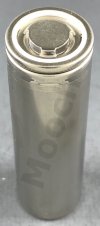
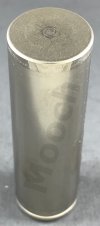
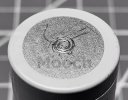
Test Results
These are wrapped as “LT 22710A” cells but are supposed to be Ampace JP40’s. I can’t guarantee that they are but there is evidence they are and they perform like JP40’s would based on their specs.
This is the best performing round cell I’ve tested for moderate to very high power applications. I have yet to to test the EVE 40PL though.
For discharging at low power levels, about 5A and lower, the Samsung 50S, BAK N21700CG-50, Molicel P50B, and LG M50LT will all run for a bit longer. But for up to about 60A this cell is incredible, running a few percent longer than the Molicel P50B and at a lower temperature.
At above 60A, pulsing at incredibly high power levels, the P50B is the better choice in my opinion due to how flat its discharge curve is. If your application draws more than 60A then I strongly recommend testing this cell, the Molicel P50B, and the EVE 40PL to see which performs the best for you. I’ve done testing at over 300W for my Patreon supporters (never exceeding 80°C limit) for this cell and others and it didn’t get noticeably damaged from this abuse.
I RECOMMEND NEVER GOING OVER THIS CELL’S 60A RATING THOUGH! It significantly increases the risks of using this cell, shortens cell life, and results in huge voltage sag,
I was wondering if this cell might have traded off cycle life for its high performance, making it “fragile” and not able to handle repeated abuse. But I put this cell through 100 abusive cycles (30A discharge/5A charge) and it only lost about 2% of its run time. That is fantastic. I don’t know the full cycle life of this cell but that’s something I’m testing for my Patreon supporters (along with the Molicel P45B and P50B, EVE 40PL, and Samsung 50S).
The cells I tested were donated by www.18650-21700.com. Thank you!
Some other general information…
Continuous Current Discharge Graphs
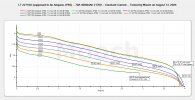
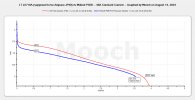
Ratings and Performance Specs Graphic
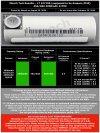
18650 Ratings and E-Scores Table:

 www.e-cigarette-forum.com
www.e-cigarette-forum.com
20700/21700 Ratings and E-Scores Table:

 www.e-cigarette-forum.com
www.e-cigarette-forum.com
I want to work for the community full time! If you feel what I do is worth a couple dollars a month and you would like early access to battery availability, battery testing and news, and a say in what I test, then please consider becoming a patron and supporting my testing efforts: Get more from Battery Mooch on Patreon.
To see how other cells have tested check out this link: Links To All 21700, 26650, 18350, 18500 Battery Tests
Misusing or mishandling lithium-ion batteries can pose a SERIOUS RISK of property damage, personal injury, or even death. Never use them outside of a fully protected battery pack and you use them at your own risk. Never exceed the battery’s true continuous discharge rating (CDR), never let it get colder than 0°C or hotter than 60°C, and keep the plastic wrap and top insulating ring in perfect condition. Never use a battery that is physically damaged in any way.
Testing batteries at their limits is dangerous and should never be attempted by anyone who has not thoroughly studied the dangers involved, understands the risks, has the proper equipment, and takes all appropriate safety precautions.
If the battery has only one current rating number, or if it only says "max", then I have to assume the battery is rated at that current level for any type of discharge, including continuous.





Test Results
These are wrapped as “LT 22710A” cells but are supposed to be Ampace JP40’s. I can’t guarantee that they are but there is evidence they are and they perform like JP40’s would based on their specs.
This is the best performing round cell I’ve tested for moderate to very high power applications. I have yet to to test the EVE 40PL though.
For discharging at low power levels, about 5A and lower, the Samsung 50S, BAK N21700CG-50, Molicel P50B, and LG M50LT will all run for a bit longer. But for up to about 60A this cell is incredible, running a few percent longer than the Molicel P50B and at a lower temperature.
At above 60A, pulsing at incredibly high power levels, the P50B is the better choice in my opinion due to how flat its discharge curve is. If your application draws more than 60A then I strongly recommend testing this cell, the Molicel P50B, and the EVE 40PL to see which performs the best for you. I’ve done testing at over 300W for my Patreon supporters (never exceeding 80°C limit) for this cell and others and it didn’t get noticeably damaged from this abuse.
I RECOMMEND NEVER GOING OVER THIS CELL’S 60A RATING THOUGH! It significantly increases the risks of using this cell, shortens cell life, and results in huge voltage sag,
I was wondering if this cell might have traded off cycle life for its high performance, making it “fragile” and not able to handle repeated abuse. But I put this cell through 100 abusive cycles (30A discharge/5A charge) and it only lost about 2% of its run time. That is fantastic. I don’t know the full cycle life of this cell but that’s something I’m testing for my Patreon supporters (along with the Molicel P45B and P50B, EVE 40PL, and Samsung 50S).
The cells I tested were donated by www.18650-21700.com. Thank you!
Some other general information…
- The datasheet lists a 60A rating but that’s temperature-limited to 80°C and is not a true continuous current rating down to the 2.5V cutoff. This cell has a 45A true continuous current rating. You can run it at 60A but must never let it get hotter than 80°C.
- Ampace’s marketing says you can pulse the JP40 at 140A for 5 seconds. Based on testing I did for my Patreon supporters I think this could be done. The voltage would be low but this cell is capable of reaching incredibly high power levels (like the Molicel P50B and EVE 40PL). Only use this cell at such high power levels if you fully understand the risk and have taken all necessary safety precautions.
- The datasheet lists a standard charge rate of 2A and a maximum of 8A. The Molicel P50B has a 25A max charge current spec. But charging any cell near its max rating will shorten the life of the cell.
- This cell has incredibly low DC internal resistance, about 5.4mOhms. This is the lowest I’ve measured for a small round cell and is most likely due to this cell’s “tabless” construction. This also helps keep the cell from “hot spotting” internally which can shorten the life of the cell.
- The four cells I tested delivered 4137mAh to 4161mAh. This is decent consistency and significantly above this cell’s 4000mAh typical capacity rating, as it should be.
- The largest of the four cells I tested was 21.1 mm in diameter and 70.2 mm in length.
- This cell has a spiral pattern stamped into the bottom of the cell. At least one other cell also has this! So don’t try to authenticate a cell that’s supposed to be a JP40 just by this feature.
Continuous Current Discharge Graphs


Ratings and Performance Specs Graphic

18650 Ratings and E-Scores Table:
18650 Battery Ratings and Performance Table
You are responsible for your own safety! These batteries are designed, manufactured, and sold only for use in a battery pack with the proper protection circuitry and battery management system. They were not designed for vaping (electronic...
 www.e-cigarette-forum.com
www.e-cigarette-forum.com
20700/21700 Ratings and E-Scores Table:
21700 Battery Ratings and Performance Table
You are responsible for your own safety! These batteries are designed, manufactured, and sold only for use in a battery pack with the proper protection circuitry and battery management system. They were not designed for vaping (electronic...
 www.e-cigarette-forum.com
www.e-cigarette-forum.com
I want to work for the community full time! If you feel what I do is worth a couple dollars a month and you would like early access to battery availability, battery testing and news, and a say in what I test, then please consider becoming a patron and supporting my testing efforts: Get more from Battery Mooch on Patreon.
To see how other cells have tested check out this link: Links To All 21700, 26650, 18350, 18500 Battery Tests

